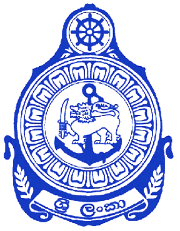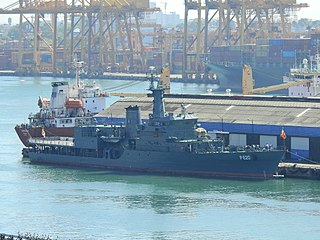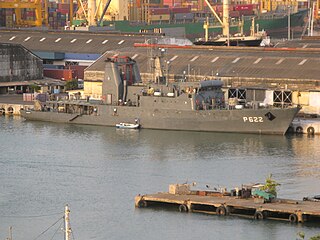Related Research Articles

The Sri Lanka Monitoring Mission (SLMM) was a multinational body that existed from 2002 to 2008 to monitor the ceasefire between the Government of Sri Lanka and the Liberation Tigers of Tamil Eelam during the Sri Lankan Civil War.

The Sea Tigers was the naval wing of the Liberation Tigers of Tamil Eelam (LTTE) during the Sri Lankan Civil War. It was founded in 1984. The Sea Tigers had a number of small but effective suicide bomber vessels. During its existence it had gained a reputation as a capable adversary for the Sri Lankan Navy. During the civil war, the Sea Tigers had sunk at least 29 Sri Lankan small inshore patrol boats, 20 Dvora-class fast patrol boats, 3 gunboats, 2 Large surveillance command ships, and one freighter.

The Sri Lanka Navy (SLN) is the naval arm of the Sri Lanka Armed Forces and is classed as the country's most vital defence force due to its island geography. It is responsible for the maritime defence of the Sri Lankan nation and its interests. The role of the Sri Lanka Navy is to conduct operations at sea for the defence of the nation and its interests and conduct prompt and sustainable combat operations at sea in accordance with the national policies.

SLNS Samudura (P621) is a Sri Lanka Navy Offshore Patrol Vessel. Originally commissioned by the United States Coast Guard in 1968 as the medium endurance cutter USCGC Courageous, she was donated to Sri Lanka in 2004 and commissioned on 19 February 2005.

The Padahuthurai bombing or Illuppaikadavai bombing happened on January 2, 2007, when the Sri Lanka Air Force bombed what they claimed to be rebel LTTE naval base in Illuppaikadavai in Northern Sri Lanka. Sri Lanka Monitoring Mission, the local Roman Catholic bishop, and the LTTE claimed 15 minority Sri Lankan Tamils, including women and children, were killed and 35 injured due to the bombing.
Operation Liberation also known as the Vadamarachchi Operation was the military offensive carried out by the Sri Lankan Armed Forces in May and June 1987 to recapture the territory of Vadamarachchi in the Jaffna peninsula from the LTTE. At the time it was the largest combined services operation undertaken by the armed forces deploying multiple brigade size formation, becoming the first conventional warfare engagement on Sri Lankan soil after the end of British colonial rule. The operation involved nearly 4,000 troops, supported by ground-attack aircraft, helicopter gunships and naval gun boats. The offensive achieved its primary objective, however operations were suspended when the Indian government dropped food supplies over Jaffna in Operation Poomalai on June 4, 1987, which prompted the Sri Lankan government to accept the Indo-Sri Lankan Accord.

SLNS Sayura is the former flagship and an offshore patrol vessel (OPV) of the Sri Lanka Navy.

SLNS Sagara(Sagara meaning: Sea) is an Offshore Patrol Vessel (OPV) of the Sri Lanka Navy. It was formerly the ICGS Varaha (41), a Vikram-class offshore patrol vessel of the Indian Coast Guard, leased to Sri Lanka in 2006 and was handed over to the Sri Lanka Navy in 2015.
The Battle of Mullaitivu, also known as the First Battle of Mullaitivu and codenamed Operation Unceasing Waves-1, was a battle between the militant Liberation Tigers of Tamil Eelam and the Sri Lankan military during the Sri Lankan Civil War for control of the military base in Mullaitivu in north-eastern Sri Lanka.
The Second Battle of Elephant Pass, was fought in April 2000 for the control of the Sri Lankan military base in Elephant Pass, Jaffna.
The Battle of Thoppigala took place between the Sri Lanka Army and the Liberation Tigers of Tamil Eelam (LTTE) fought during a period of the first half of 2007 over control of the LTTE-dominated peak of Thoppigala, located 40 km northwest of Batticaloa, in eastern Sri Lanka.
The Battle of Pooneryn took place between the militant Liberation Tigers of Tamil Eelam and the Sri Lankan military during the Sri Lankan Civil War for control of the military base in Pooneryn in northern Sri Lanka from 11 November to 14 November 1993.
The Northern Theatre of Eelam War IV refers to the fighting that took place in the northern province of Sri Lanka between July 2006 and May 18, 2009.
Operation Balavegaya was a combined military operation launched by the Sri Lankan military in Jaffna, the largest amphibious assault in its history. Operation Balavegaya was launched in response to the siege of Elephant Pass by the LTTE. It is believed that Operation Balavegaya was the largest and most successful military operation of the Sri Lankan military until Operation Riviresa in 1995.
The Battle of Vavunathivu took place during the Sri Lankan Civil War. It occurred on 7 March 1997 in which the LTTE militants attacked and overran the Sri Lanka Army military camp at Vavunathivu off Batticaloa.

The Victoria Affair was a military operation conducted by the Israel Defense Forces (IDF) in March 2011 in which the Israeli Navy intercepted the vessel Victoria on the international waters in the Mediterranean, and discovered concealed weapons which, according to the IDF, were destined for Palestinian militant organizations in the Gaza Strip. The vessel was found to be carrying approximately 50 tons of weapons, including C-704 anti-ship missiles, rocket launchers, radar systems, mortar shells and rifle ammunition.
Divisions of the Liberation Tigers of Tamil Eelam refers to the military, intelligence and overseas divisions the Liberation Tigers of Tamil Eelam (LTTE). Most of these divisions were destroyed during the Eelam War IV, and only parts of the intelligence and financing divisions remain overseas.
There are allegations of various types of criminal activities levelled against the Liberation Tigers of Tamil Eelam (LTTE) by state actors and agencies.
The Battle of Pulukunawa took place during the Sri Lankan Civil War. It occurred on 11 December 1996 in which the LTTE militants attacked and overran the Special Task Force detachment at Pulukunawa in Ampara.
References
- ↑ The Man Behind The Naval Strategy
- ↑ Sri Lankan Navy seizes rebel arms smuggling ship
- ↑ Sri Lanka Navy Outlines Importance of Maritime Hub in Seminar Sessions
- ↑ Wijayapala, Ranil. "Navy Chief assesses Navy's role in the Forces' successful campaign to eliminate LTTE terrorism". Daily News. Retrieved 6 January 2024.
- ↑ "LTTE Vessel with Arms &; Other Items Goes in Flames after Navy Intercepted". army.lk. Sri Lanka Army. Retrieved 6 January 2024.